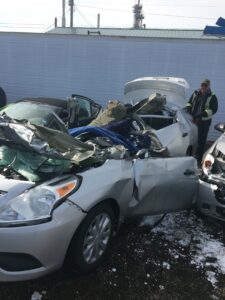Posted in Accident Data on May 1, 2023
Did you know that there are over 6 million car accidents each year? Interestingly, many people are unaware of the fact that there are many different types of car accidents.
We’ve put together a car accident guide that has all of the information you need to know. Let’s take a closer look.
1. Rear-End Collisions
This is when a car hits the back of another vehicle, often due to driver distraction, tailgating, or sudden stops. Rear-end collisions can result in significant property damage even though they are often minor.
For instance, a rear-end collision can cause the bumper of a car to bend or break, and airbags may deploy.
2. T-Bone Accidents
These accidents can result in serious injuries and even fatalities. They occur for a variety of reasons. These include driver negligence, vehicle maintenance negligence, and hazardous road conditions.
They often happen when one driver fails to yield the right-of-way or is speeding. Running a red light is a common example.
3. Head-on Collisions
Two cars collide head-on, often resulting in severe injuries or fatalities.
This type of accident is most often caused by a driver veering into the wrong lane, speeding, or drunk driving. As you might anticipate, head-on collisions can be deadly or cause injuries that require long-term medical care.
4. Rollover Accidents
These crashes happen when a car rolls over onto its side or roof due to a collision. This could be with another vehicle, with an object, or by losing control while traveling at high speed. Rollovers often occur in vehicles such as SUVs, vans, and trucks that have a higher center of gravity than other cars.
Unfortunately, rollovers can easily cause serious injuries or death.
5. Pedestrian Accidents
As the name implies, these accidents involve a vehicle hitting a pedestrian. Devastating injuries and fatalities are often the result. Pedestrian accidents usually occur when drivers are distracted, speeding, or failing to yield the right-of-way.
Even if drivers manage to avoid hitting pedestrians on the street, they may run into pedestrians in parking lots, driveways, and other areas.
Pedestrian accidents often involve distracted drivers who fail to see pedestrians in their peripheral vision. Pedestrians may cross against traffic signals or not use designated walkways, which increases their risk of suffering an injury.
6. Single Vehicle Accidents
This is when a car crashes into an object such as a tree, guardrail, or embankment, usually due to driver error. Single-vehicle accidents can occur for a variety of reasons, such as driving too fast for conditions or inattention.
Common types of single-vehicle accidents include hitting a guardrail, running off the road, and hydroplaning. Others could involve hitting an animal, debris in the roadway, or even a pedestrian.
7. Multi-Vehicle Pileups
These involve multiple vehicles and often occur on highways or other high-speed roads in adverse weather conditions. Multi-vehicle pileups are caused by drivers following too closely, distracted driving, or other forms of reckless driving.
These types of crashes often result in serious injuries and fatalities.
8. Hit-and-Run Accidents
These occur when a driver flees the scene of an accident without stopping to help after an accident they caused. Hit-and-run accidents are a major problem, as the victim is left to deal with the aftermath on their own.
It’s important that drivers remain at the scene of an accident until all necessary information has been exchanged.
Common Injuries
Some of the most common injuries in car accidents include whiplash, spinal cord damage, and head injuries. Depending on the type and severity of the accident, injuries can range from minor to catastrophic.
To clarify, a catastrophic injury is defined as an injury that permanently prevents the victim from returning to their previous lifestyle and activities.
The consequences of car accident injuries can be long-lasting, and victims may require expensive medical treatment for a prolonged period of time. In some cases, the victim may never fully recover from their injury.
It’s important to have an attorney on your side to help you get the compensation you deserve. When searching for an attorney, make sure to find one who is knowledgeable about car accident laws and has experience working with insurance companies. They should be able to provide you with the guidance and representation necessary to get the best possible outcome for your case.
A good lawyer can also help you understand your rights and the legal process so that you can make informed decisions throughout.
Preventive Measures
There are several preventive measures that can be taken to reduce the risk of car accidents, including:
- Paying attention to the road and avoiding distractions
- Obeying speed limits and traffic laws
- Avoid driving under the influence of drugs or alcohol
- Wearing a seatbelt and making sure all passengers do the same
- Have your car regularly maintained to ensure it is in good working order
- Make sure you are alert and well-rested before driving
- Knowing your vehicle’s blind spots, especially when changing lanes
Taking defensive driving courses and practicing safe driving habits are also viable options. By taking these measures, you can help reduce the risk of being involved in a car accident and ensure that you are prepared should one occur.
Understanding Types of Car Accidents
By understanding the different types of car accidents, drivers can take necessary precautions to prevent them from occurring. This will go a long way toward keeping you as safe as possible in the future.
Keep the above information in mind so that you can stay prepared. Looking for more information about what we can do? Get in touch with us today to see how we can help.



